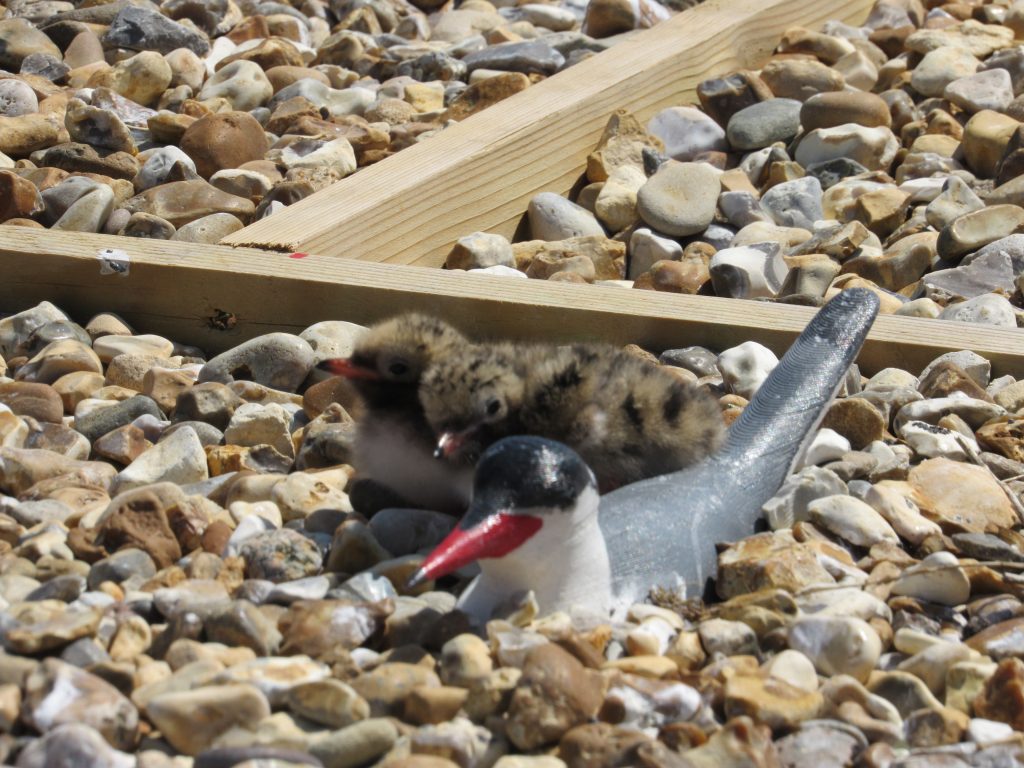- 29 breeding pairs nest on newly built rafts at RSPB Medmerry.
- Decoy birds and seabird song, played through speakers, used to attract Common Terns.
- Special ‘chick shelters’ have been used to protect tern chicks.
- RSPB Medmerry has also restored four shingle islands for threatened shorebirds including Gulls, Sandwich Terns, Little Terns and Ringed Plovers.
By playing tern calls through speakers and deploying model birds, our partner, the RSPB, has attracted 29 breeding seabird pairs since installing two floating rafts at Medmerry in the spring.
Common Terns are often reluctant to adopt new places to breed, but their habitat is being squeezed by urban development on the Solent. As such, the quick uptake of the rafts by eight pairs of terns and 21 pairs of Black-headed Gulls represents an unusually swift success for local seabirds.

The rafts were installed in March this year, floating in a saline lagoon at RSPB Medmerry nature reserve. Common Terns flying overhead will have spotted the model birds, convincing them that the rafts were a safe place to rest and breed. Terns which did not see the model birds may have heard the ‘audio lure’ instead. By playing the sound of Common Terns through speakers on the rafts, terns will have been enticed to investigate and nest.
Wez Smith, Senior Project Manager for the RSPB said:
“It’s such a joy to have terns and gulls now nesting and raising young on the Medmerry nature reserve. Since its creation in 2013, the site has seen ongoing growth of wildlife making its home here. Now, thanks to the work carried out this year, we have the start of a new seabird colony, and a new beginning”.
Why were the rafts installed?
A ground nesting species, Common Terns are vulnerable to predation and disturbance. The rafts offer protection from any predators which cannot fly, and greatly reduce the risk of human activity accidently disrupting the breeding process.
Once the terns had nested and laid eggs, ‘chick shelters’ were installed to protect them from predators. These allow the chicks and their parents to enter and exit the temporary shelters, while stopping other species getting into the nest from above.
Beach-nesting birds such as Ringed Plovers, Little Terns and Oystercatchers also stand to benefit from the restoration of shingle to four islands at Medmerry. Restoring this habitat allows new space for threatened species like Little Terns and Ringed Plovers, helping to create a diverse network of different habitats on the Solent.

Why are we protecting seabirds?
Seabirds are the most threatened bird group in the world, and our UK seabird populations are in a dire state. The latest seabird census revealed that a shocking 62% of UK seabird species are in decline and they are also failing to meet the Good Environmental Status target under the UK Marine Strategy. Seabirds are a key indicator of the state of our overall marine environment.
The UK has lost more than 15% of its intertidal habitat since 1945, including 8,000 ha of saltmarsh and even more mudflat (Office of National Statistics 2016). In addition, it has lost 46% of its shingle and 18% of its dunes.
Common Terns breed on shingle beaches, rocky islands and inland on the gravelly shores of lakes and rivers. They are noisy in their colonies and hover over the water before plunge-diving to catch their fish prey. They are on the UK’s Amber List for Birds of Conservation Concern, meaning it is a species of conservation concern.
How was the work funded?
The shingle restoration and nesting rafts are part of the Solent Seascape Project (SSP). The rafts were funded by the Species Survival Fund, a partnership between Defra and the National Lottery Heritage Fund, and are part of SSP. By supporting a breeding population of terns and Black-headed Gulls, the rafts at Medmerry are helping to provide more plentiful and joined up habitat for wildlife on the South Coast.



